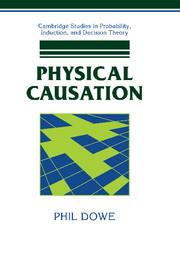Book contents
- Frontmatter
- Contents
- Acknowledgements
- 1 Horses for Courses: Causation and the Task of Philosophy
- 2 Hume's Legacy: Regularity, Counterfactual and Probabilistic Theories of Causation
- 3 Transference Theories of Causation
- 4 Process Theories of Causation
- 5 The Conserved Quantity Theory
- 6 Prevention and Omission
- 7 Connecting Causes and Effects
- 8 The Direction of Causation and Backwards-in-Time Causation
- References
- Index
3 - Transference Theories of Causation
Published online by Cambridge University Press: 13 October 2009
- Frontmatter
- Contents
- Acknowledgements
- 1 Horses for Courses: Causation and the Task of Philosophy
- 2 Hume's Legacy: Regularity, Counterfactual and Probabilistic Theories of Causation
- 3 Transference Theories of Causation
- 4 Process Theories of Causation
- 5 The Conserved Quantity Theory
- 6 Prevention and Omission
- 7 Connecting Causes and Effects
- 8 The Direction of Causation and Backwards-in-Time Causation
- References
- Index
Summary
In this chapter I examine non-Humean 'transference' accounts of causation due to Aronson and Fair. I show that this kind of account fits well with the cases of indeterministic causality and chance-lowering causality discussed in the previous chapter. I also propose a way to extend those accounts into a full conceptual analysis, thereby developing the idea of transference as a meaning analysis.
However, there are a number of difficulties with the transference account. These concern problems of the identity over time of the transferred quantities, and the direction of causation. Further, I argue that there is a kind of causation, immanent causation, or causation as persistence, which is neglected by the transference accounts. I spell these out these concerns in section 3.4.
REVIEW OF TRANSFERENCE THEORIES
The key idea of transference theories of causation is that a cause transfers something like energy to its effect, which makes causation a singular matter. Although this cannot be what we mean when we use the word cause, it is a plausible candidate for an empirical analysis, and one which has been widely held in previous centuries. In this chapter we consider the two most influential proponents of this approach, Ron Aronson and David Fair.
Aronson's Transference Theory
Aronson's theory was first offered in two papers in 1971, in deliberate contrast to manipulability accounts (1971b) and regularity accounts (1971a).
- Type
- Chapter
- Information
- Physical Causation , pp. 41 - 61Publisher: Cambridge University PressPrint publication year: 2000

